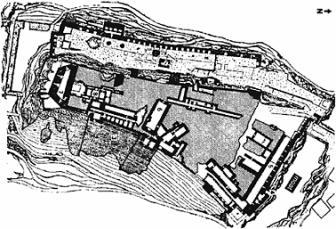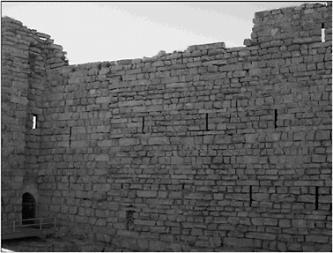Muslim Fortresses in the Levant: Between Crusaders and Mongols (95 page)
Read Muslim Fortresses in the Levant: Between Crusaders and Mongols Online
Authors: Kate Raphael
Tags: #Arts & Photography, #Architecture, #Buildings, #History, #Middle East, #Egypt, #Politics & Social Sciences, #Social Sciences, #Human Geography, #Building Types & Styles, #World, #Medieval, #Humanities

Although several inscriptions were found and published their original location in the fortress is not always clear. The southern keep has a long band inscription, though its location at the top of the tower, makes it impossible to read (it appears to have been almost ignored by most scholars). The two inscriptions that commemorate the urban fortifications of Baybars have been recorded and cited by several authors who have studied this site. They are set on the two large towers inserted along the town fortifications. The first, on the northwest corner tower, was recorded by Luynes as “Tour dite de Malek ed Daher,” the second as “Tour al Banawī,” a semi-circular tower along the southeast section of the town wall.
184
None of the inscriptions published to date commemorates Baybars’ work in the fortress.
Karak rates among the principal fortresses conquered and rebuilt by the Mamluks in the southern regions of Syria, and is the largest of the fortresses in Trans-Jordan. It has three distinct sections (
Figure 4.24
). The two later sections ere built by Baybars and their construction was completed in his lifetime as attested by the inscription.
Although there is more than one Crusader building phase I shall only briefly touch on the subject when analyzing and comparing the various structures and forms used by the Franks, the Ayyubids and the Mamluks. However, it is important to note here that the Crusader plan and building techniques are neither the most sophisticated nor of the finest quality.
185
Nevertheless they withstood all three of al-Dīn’s sieges, attesting to the strength of both fortress and garrison.
al-Dīn’s sieges, attesting to the strength of both fortress and garrison.
186
The core of the fortress has a trapezoid shape. It is easily distinguished by the dark, hard, coarsely dressed stone.
187
The rectangular towers along the eastern and western sides are modest in size. Since they hardly protrude from the curtain wall they provide very poor vision, leaving much of the ground below the wall out of the defenders’ sight. The towers are sparsely distributed and fitted with small and relatively few arrow slits. The vast vaulted halls along the northern side, described by

Figure 4.24
Karak: (1) the heart of the fortress, built by the Franks in two phases (1142–88); (2) the western galleries; (3) the southern keep

Figure 4.25
Karak, the Frankish entrance along the northeast corner
Kennedy as “Victorian railway tunnels,” are no doubt the most impressive features of the Frankish building phase.
188
An entrance was constructed at the seam between the northeastern tower and the gallery wall (
Figure 4.25
). The outer defense lines included a glacis that surrounded the walls on the eastern and southern sides, and the wide moat on the north. The moat is described y Ibn Shaddād as being extremely deep, 60 , which equals 34.8m.
, which equals 34.8m.
189
The depth of the moat and its effectiveness against enemy forces were demonstrated by an accident that occurred while Qalāwūn and his entourage were crossing the bridge above the moat:
The bridge of the castle collapsed under them …When the steed felt the bridge collapsing, it thrust forward until it almost trampled the amirs marching before him. Thity five Mamluks of our lord sultan fell into the fosse. … the sultan dismounted at the gate, sent for tackle and ropes, fetched up everyone who had fallen and ordered them to be treated … for the height of the bridge from which they fell into the fosse was nearly fifty cubits.”
190
By the end of the Frankish rule at Karak, the total circumference of the fortress was 730m. It was defended by nine towers distributed along the west, east and south (those along the south were later destroyed by Baybars).
If the fortress underwent any changes during the Ayyubid period no architectural evidence remains. This is most peculiar, considering that the Ayyubids held Karak for seventy-five years in which the region was often affected by military and political strife.
Some evidence of Ayyubid architecture
Trans-Jordan was extensively fortified during the Ayyubid period. In addition to existing Crusader fortresses that were taken and reestablished, new fortresses were built at (1188–92),
(1188–92), (1220) and al-Azraq (1236–7).
(1220) and al-Azraq (1236–7).
191
As noted above, evidence of Ayyubid construction or even repairs within the fortress grounds is elusive and an archaeological excavation may well be required in order to trace and find conclusive and tangible remains. Thus the only knowledge we have comes from the historical sources and a foundation inscription that may relate to work at the fortress. The most important details, however, are missing. We are not told what building he built and since the inscription was not found
work at the fortress. The most important details, however, are missing. We are not told what building he built and since the inscription was not found
in situ
we have no means of knowing to which building it belonged. It does, however, state the name of the supervisor of the work, al-Dīn Abū
al-Dīn Abū Barghash, who was employed by
Barghash, who was employed by on a previous construction project at the stronghold of
on a previous construction project at the stronghold of
 (Sinai) in 578/1183.
(Sinai) in 578/1183.
192
